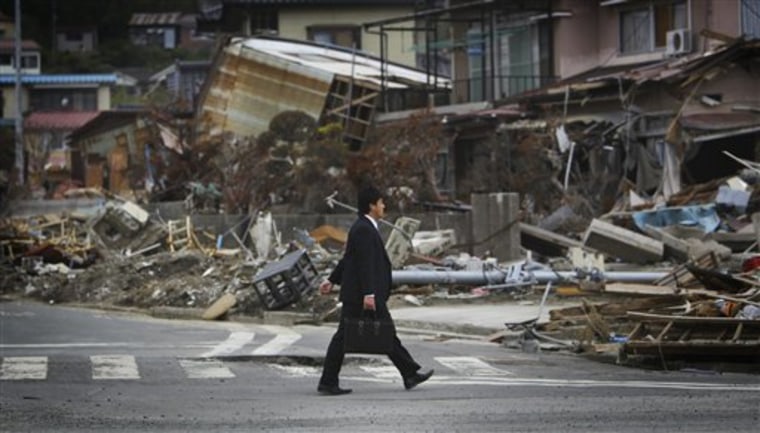One of the reactors at Japan's crippled nuclear power plant has been damaged more severely than originally thought, officials said Thursday — a serious setback for efforts to stabilize the radiation-leaking complex.
Repairs to monitoring equipment revealed the new data, which also showed that the water level in the core of Unit 1 at the Fukushima Dai-ichi plant is much lower than previously thought, leaving the portion of the fuel rods still intact fully exposed. Other fuel has slumped to the bottom of the pressure vessel and is thought to be covered in water.
The findings also indicate a greater-than-expected leak in that vessel. Radioactive water pouring from troubled reactors has pooled around the complex, hindering work to bring the plant under control.
However, temperatures in the unit are still far below dangerous levels because the plant's operator, Tokyo Electric Power Co., continues to inject new water to keep the rods cool. That radioactive water is apparently then leaking into and through the larger, beaker-shaped drywell, or containment vessel.
"The situation (in the core) hasn't changed since (early in the crisis), and the fuel rods are being cooled by water continuously being injected into the core," nuclear official Takashi Sakurai said.
Nuclear Industrial and Safety Agency officials said the new data indicates that it is likely that partially melted fuel had fallen to the bottom of the pressurized vessel that holds the reactor core together and possibly leached down into the drywell soon after the March 11 quake and tsunami that struck Japan's northeastern coast.
While officials said it was unlikely that the chunks of fuel were still dangerously hot or that they could melt through the concrete base of containment vessel, they acknowledged that the level of damage could complicate plans detailed in April to bring the plant to a cold shutdown within nine months. Further examination was needed to ascertain the full extent of damage, they said.
TEPCO had adopted an unorthodox method of trying to cool Unit 1's reactor by trying to fill the drywell with water leaking from the core, but the possibility that chunks of melted fuel had fallen and damaged part the containment vessel raised questions about how successful this method would be. It also called into question the utility's timeline for stabilizing the reactor.
"We have to revise the flooding method, as we need to re-examine the way we carry it out," Matsumoto said.
Recent temperatures inside Unit 1's core were at the most 237 degrees Fahrenheit (114 Celsius), well below the normal operating temperature of about 570 Fahrenheit (300 Celsius). Zirconium fuel rod casing begin to break down at 2,200 Fahrenheit (1,200 Celsius) and melt at 3,900 Fahrenheit (2,200 Celsius).
The new findings became available as workers fixed a water meter Tuesday after entering the building for the first time since a March 12 hydrogen explosion at the unit.
The gauge showed that the water was at least three feet (one meter) below the 13-foot-long (four-meter-long) fuel rods, which are suspended in the pressure vessel. Some of the rods has melted away, however, and the chunks of damaged fuel are presumed to be sitting at the bottom of the vessel, covered in water.
The low level of water indicates that the core of Unit 1 had a bigger breach than expected, said TEPCO spokesman Junichi Matsumoto.
Cooling water has been leaking from the reactor cores of Units 2 and 3 as well, allowing an estimated 70,000 tons of contaminated water to pool inside the complex, which TEPCO has been struggling to bring under control for two months.
To prevent contaminated water from leaking into the ocean, workers in April began pumping it into a waste processing building while a system to decontaminate the water is set up.
The plant, 140 miles (220 kilometers) north of Tokyo, has a total of six reactors. Units 5 and 6 have already reached cold shutdown. Unit 4 contained no fuel rods at the time of the earthquake, but workers have needed to spray water into its spent fuel pool where still-hot rods are stored and structural damage and leakage are suspected.
The government on Thursday also delayed the announcement of a plan to ensure that TEPCO fulfills its obligation to compensate tens of thousands of people affected by the crisis. Prime Minister Naoto Kan said further discussion was needed.
Under the plan, a new fund would be created with mandatory contributions from electric utilities, including TEPCO, in case TEPCO's total compensation exceeds its financial capacity. The government could also add public money if needed.
TEPCO would be required to repay any money it uses from the fund. The utility has agreed to drastic restructuring, cost-cutting and other conditions in exchange for government support in the compensation scheme.
